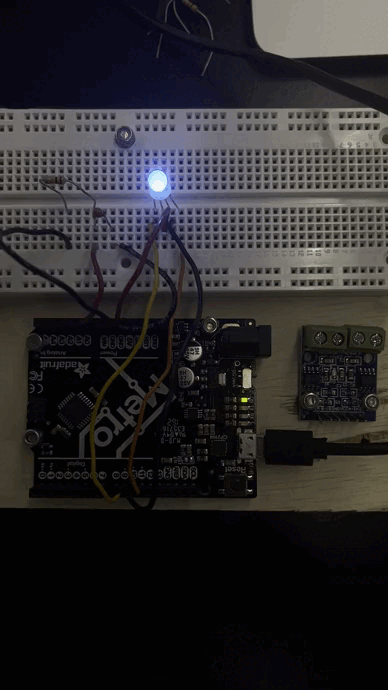# input device
# ---------------------------------
for my input device, i wanted to try using the thermistor for the first time.
using this tutorial, i built the circuit for the
thermistor and was able to calibrate it to display the temperature in my serial monitor using the following code:
int ThermistorPin = 0;
int Vo;
float R1 = 10000;
float logR2, R2, T;
float c1 = 1.009249522e-03, c2 = 2.378405444e-04, c3 = 2.019202697e-07;
void setup() {
Serial.begin(9600);
}
void loop() {
Vo = analogRead(ThermistorPin);
R2 = R1 * (1023.0 / (float)Vo - 1.0);
logR2 = log(R2);
T = (1.0 / (c1 + c2*logR2 + c3*logR2*logR2*logR2));
T = T - 273.15;
T = (T * 9.0)/ 5.0 + 32.0;
Serial.print("Temperature: ");
Serial.print(T);
Serial.println(" F");
}
and here is the circuit:

# output device
# ---------------------------------
for my output device, i wanted to try using the RGB LED. i followed this tutorial, and used their model of creating
a separate function to set the values for R, G, and B.
here is the code:
int red_light_pin= 9;
int green_light_pin = 10;
int blue_light_pin = 11;
void setup() {
pinMode(red_light_pin, OUTPUT);
pinMode(green_light_pin, OUTPUT);
pinMode(blue_light_pin, OUTPUT);
}
void loop() {
RGB_color(10, 20, 30);
}
void RGB_color(int red_light_value, int green_light_value, int blue_light_value){
analogWrite(red_light_pin, red_light_value);
analogWrite(green_light_pin, green_light_value);
analogWrite(blue_light_pin, blue_light_value);
}
and then, i built the circuit:

# bringing them together
# ---------------------------------
essentially, for the final product, i wanted to make the LED change color in accordance with the temperature. the simplest way of doing this was
to make one of the LED color values equal to the temperature.
this resulted in this code (essentially, combining the two previous programs and adding a temperature-dependent LED setting function):
int ThermistorPin = 0;
int Vo;
float R1 = 10000;
float logR2, R2, T;
float c1 = 1.009249522e-03, c2 = 2.378405444e-04, c3 = 2.019202697e-07;
int red_light_pin= 9;
int green_light_pin = 10;
int blue_light_pin = 11;
void setup() {
Serial.begin(9600);
pinMode(red_light_pin, OUTPUT);
pinMode(green_light_pin, OUTPUT);
pinMode(blue_light_pin, OUTPUT);
}
void loop() {
RGB_color(T, 5, 5);
Vo = analogRead(ThermistorPin);
R2 = R1 * (1023.0 / (float)Vo - 1.0);
logR2 = log(R2);
T = (1.0 / (c1 + c2*logR2 + c3*logR2*logR2*logR2));
T = T - 273.15;
T = (T * 9.0)/ 5.0 + 32.0;
Serial.print("Temperature: ");
Serial.print(T);
Serial.println(" F");
}
void RGB_color(int red_light_value, int green_light_value, int blue_light_value)
{
analogWrite(red_light_pin, red_light_value);
analogWrite(green_light_pin, green_light_value);
analogWrite(blue_light_pin, blue_light_value);
}
unfortunately, this did not lead to significant visible changes in the color because the temperature fluctuation
i could achieve was not particularly high. to solve this, i made one change — to set the RED value to (T-70)^2, which
made it so that small variations in temperature would lead to larger changes in color
here is the final product in action (using my fingers as a heat source to increase the temperature detected by the thermistor)



